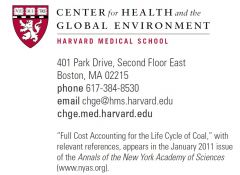 Dr. Paul Epstein from the Center for Health and the Global Environment at Harvard’s Medical School has written an article quantifying the true costs of coal in terms of economic, health and environmental impacts. Dr. Epstein’s study details how each stage of coal’s life cycle (extraction, transportation, processing, and combustion) has enormous costs, all of which are directly borne by the public. Notably, the report estimates some $74.6 billion a year in public health costs for Appalachian communities, mainly from increasing healthcare burdens, injury and death.
Dr. Paul Epstein from the Center for Health and the Global Environment at Harvard’s Medical School has written an article quantifying the true costs of coal in terms of economic, health and environmental impacts. Dr. Epstein’s study details how each stage of coal’s life cycle (extraction, transportation, processing, and combustion) has enormous costs, all of which are directly borne by the public. Notably, the report estimates some $74.6 billion a year in public health costs for Appalachian communities, mainly from increasing healthcare burdens, injury and death.
Beyond the direct health damage coal extraction and burning has on communities, the American public is paying $187.5 billion due to air pollutants, $29.3 billion for mercury poisoning, and anywhere between $61.7 and $205.8 billion for global warming emissions. Although this is an American study we in Australia - and South East Queensland will be bearing similar impacts. Read more about this story or an executive summary here.http://wvgazette.com/static/coal%20tattoo/HarvardCoalReportSummary.pdf
This is timely research as our Queensland Government approves more mining exploration amidst the World Heritage listed Mt Barney. All over South East Queensland mining companies are wanting to extend the exploitation of our areas most valued for the richness of biodiversity. During the 2011 INTERNATIONAL YEAR OF FORESTS for people which seeks to have members of the human species become more aware of our connections with healthy forest systems. Healthy forests equals a healthy life sustaining enviroment for healthy people.
Beyond dollar evaluations, qualitative impacts include harm to air quality,watersheds, land, plants, animals, families and communities. The proposed technology of CCS is costly and risky, and is projected to magnify the ecological and health footprint of coal. The extent of environmental harm is such that instead of more coal mines we should be phasing fossil fuel production out and bringing in renewable non degrading processes - especially where we can apply closed loop cycles - as does nature.